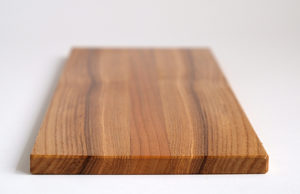We are fascinated by people who create things with their own hands – something we can touch and use in our daily lives. Wood is a great accessory for tea – it also is a woody plant after all… Vlasta Hanuš makes tea trays and tables, which you can admire in our shop.
VLASTA ABOUT HIMSELF
“I have worked with wood for some time. But it’s been only a couple of years that woodwork became my profession. I have been at several universities, but it still didn’t feel it was the right thing for me. I decided to take up carpentry and wood carving in Příbram – and it seems this finally is what I’d been looking for. My workshop is in “Czech Canada” near Nová Bystřice.
For me, wood is not just a material. It is a co-author and should not be anonymous. I work mainly with our local wood. Most of it I discover, cut and dry myself, so I am in contact with it from the very beginning – from a moment it wasn’t material, but a body of a tree.
tree
not wood under bark
it has a living, pulsating body
full of water, full of juices
it keeps moving
Apart from making tea accessories I mainly do wood carving, inlays, gilding − and I make musical instruments. I was strongly influenced by the north-Bohemian sculptor and carver Iveta Sadecká and her original approach to wood, which was inspired by Goethean art. I also love the work of Andy Goldsworthy − his way of working with shape, changeability and impermanence in the course of time.
I prefer hand tools: chisels, planes, Japanese saws, scratches… that’s my thing. Work with them is a pleasure itself! I use machines merely for the rough formatting of the wood at the beginning.
In surface treatment, there’s nothing like a clean cut with a sharp tool. That’s why I’m not into sand paper. It tears the wooden fibres, while sharp tools make clean cuts. This is another reason why I often keep chisel and plane marks on my products. For surface treatment I use almost exclusively plant oils, waxes and shellac. The wooden surfaces aren’t plastered with a layer of synthetic email, but are sufficiently resistant.
I also enjoy planting trees – which completes the circle of working with wood. My orchard is full of old varieties – mainly apple and pear trees – and plenty, plenty of seedlings.”
WORK WITH WOOD
The basic principle for shaping wood with hand tools – planes and chisels – is to respect the properties of the material. Unlike metal, glass and plastic, wood is not homogeneous. It is a material that used to be a living body in flow. It has different properties in all directions, depending on the way the tree grew. It is important to know the direction and undulations of the fibres, the way they go around knags… A carver has to take into account all this to be able to work with wood successfully, achieve precise finishing and clean strokes.
Mastering the craft, tools and the material is absolutely essential. This allows one to freely transfer their idea into a material through their hands and tools. Art must be based on a foundation of craft.
SURFACE TREATMENT AND COLOURING
 I prefer finishing with plant oils and waxes, not hiding beautiful wooden surfaces with synthetic varnish. When you touch wood, it’s still wood. Oils are good at making the colour and structure of wood stand out. They give it what we call “wet effect”. With wood that doesn’t have an outstanding or interesting pattern I sometimes reach out for natural pigments. To darken wood, I often use the walnut peel pigment. I also have experimented with a number of plants, indigo, ash and rock pigments.
I prefer finishing with plant oils and waxes, not hiding beautiful wooden surfaces with synthetic varnish. When you touch wood, it’s still wood. Oils are good at making the colour and structure of wood stand out. They give it what we call “wet effect”. With wood that doesn’t have an outstanding or interesting pattern I sometimes reach out for natural pigments. To darken wood, I often use the walnut peel pigment. I also have experimented with a number of plants, indigo, ash and rock pigments.










































